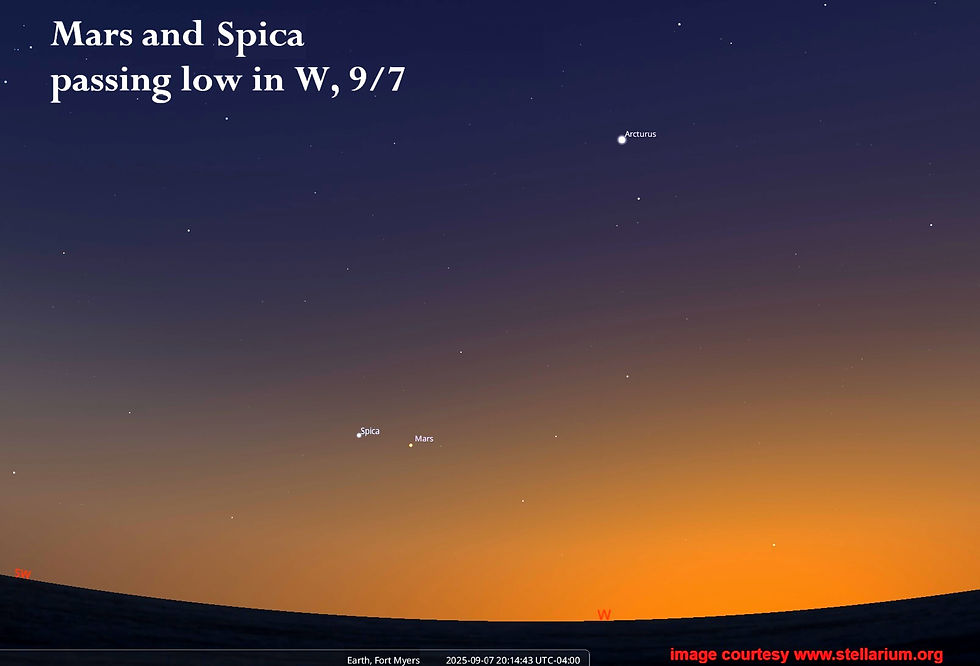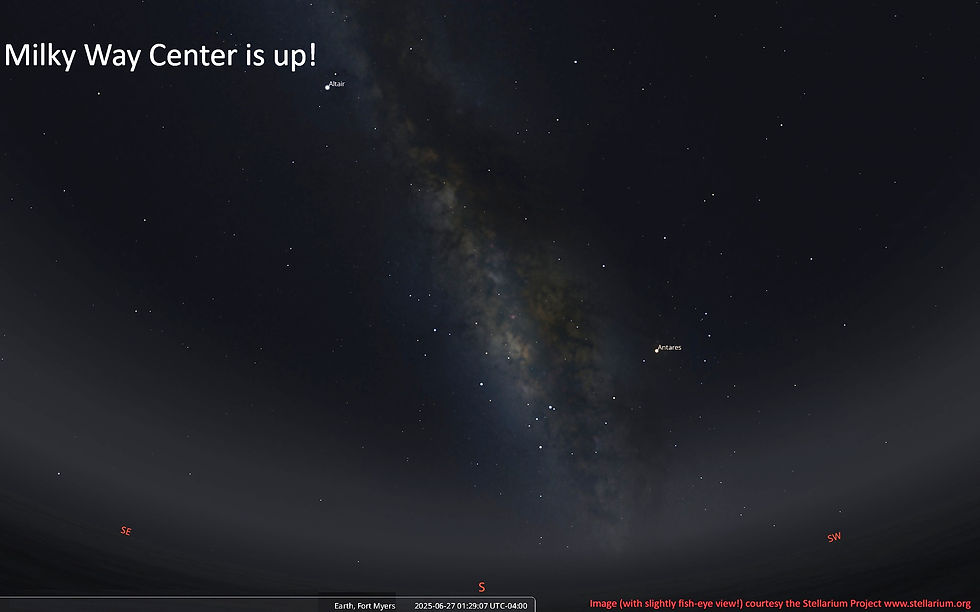What's Up in SW FL Skies: September Equinox and Planetarium Grand Re-Opening -- also Planets and Constellations this month
- heather92475
- Sep 9, 2024
- 3 min read
Moon Phases September 2024 (Eastern Time)
New 1st Quarter Full (Harvest Moon) 3rd Quarter
2 11 17 24
Meteors: September Epsilon Perseids peak September 9th
The Epsilon Perseid shower is active from September 5 - September 21. This shower has a bit of a mystery associated with it! On the basis of determined heliocentric orbits, the parent body of the September Epsilon Perseid shower is an unknown long-period comet with a retrograde orbit, with an orbital period something like a thousand years! Perhaps our grandchildren will discover the "parent comet" of this shower!
A very subtle lunar eclipse
The Moon is full on the night of the 17th - the famous "harvest moon." But if it looks like a little bite is being taken out of it at the upper left from about 10:15 to 11:15 pm, that's great observing on your part! At maximum, Earth’s shadow eclipses less than ten percent of the Moon during this eclipse. The partial eclipse starts at 10:12 pm EDT, maximum eclipse occurs at about 10:45 pm, and the partial eclipse ends at 11:15 pm.
September Equinox
The "autumnal" equinox, occurring at 8:44 am on September 22, marks the start of the fall season in the northern hemisphere. The word equinox means equal night — meaning night and day are roughly the same amount of time. The Sun also rises directly east and sets directly west on the equinox - or as close as the few hours' difference will allow!
Planets: Sunset, Night and Dawn
Venus is the early evening planet at the start of the month: Venus is the bright one low in the West-Southwest after sunset. Brilliant Venus will dominate the lower western sky by 8 pm
At the beginning of the month, the planet Saturn rises is already above the eastern horizon once it's fully dark out. The bright star to Saturn's lower right is the lovely southern hemisphere star, Fomalhaut.
Around midnight, Jupiter will join the SE sky and then nearly an hour later Mars will follow it.
Mercury appears low in the east before dawn and heads closer to the Sun as the month progresses -- by September 21 or so it should start to get lost in the glare of the rising Sun.

The Stars of Summer Transition to the Stars of Winter: Summer Triangle to Winter Hexagon
On any evening – from now through fall – you'll be able to spot the famous Summer Triangle, which at our latitude is practically overhead at its highest point of the night. Made of the brightest star in each of three constellations, it's an easy-to-see large triangle in our summer-to-late-fall skies. It’s quite high above the southern horizon as the sky darkens on September evenings.
The three bright stars are (from west to east to southernmost): Vega in the constellation Lyra (the Lyre), Deneb in the constellation Cygnus (the Swan), and Altair in the constellation Aquila (the Eagle). Each star will rise a few minutes earlier each day, so the Summer Triangle will start each night just a bit higher in your sky than it was the night before.
However, by the predawn hours, you will see the bright stars of winter above your eastern horizon, with the constellations Orion (with bright stars Betelgeuse and Rigel) and Taurus (with brilliant Aldebaran), and Orion's two famous hunting dogs, the bright "dog stars," Sirius (in Canis Major) and Procyon (in Canis Minor), plus Castor and Pollux in Gemini, and Capella - the bright star in Auriga. Six bright winter stars surround Betelgeuse [pronounced BEEtle-juice] in what is nicknamed the Winter Hexagon.
Grand Re-Opening Event: Sept 27 celebration
Last month, the planetarium underwent a great renovation. We had not changed our seating since our opening in 1986, and now at last the interior upgrade has happened! We now have new roomier seating rows, new carpeting, new plushy seats that rock back (with the super-plushy VIP section in the back of the theater, for a comprehensive view), better sight lines, and a rebuilt stage for our live performances. At the same time, we have replaced the planetarium roof: a noisy and messy process it was, but we can look forward to no rain in the dome now :-)
We can hardly wait for you to join us September 27th for our grand re-opening open house! You can come preview the seats by visiting Tuesday through Sunday all month long, but September 27th is the open house - come visit and try the seats.
The whole nature center, planetarium, butterfly aviary, raptor aviary and trails complex is open six days per week, closed Mondays. Hoping to see you soon at the Center!
-- Heather Preston, Planetarium Director





Comments